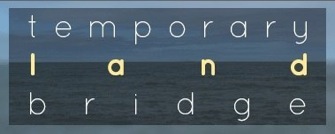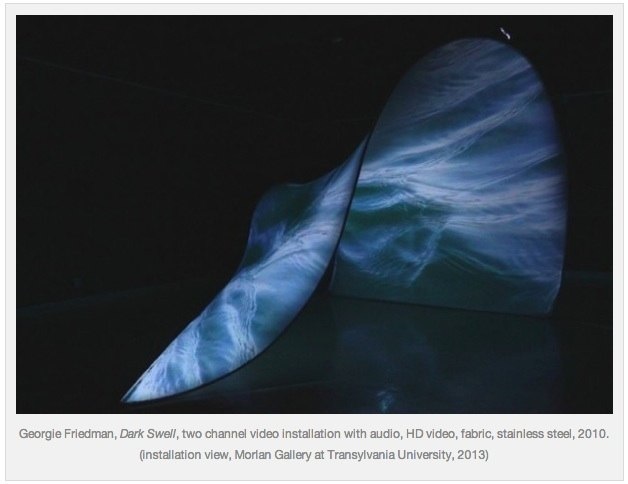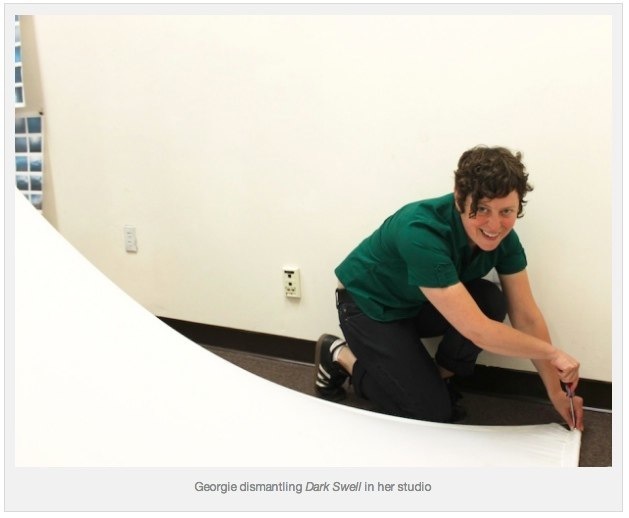news | upcoming


interview
Temporary Land Bridge Interview
Posted on October 8, 2013 by ANDREA SHERRILL EVANS
Georgie Friedman (b. North Carolina, USA) is a Boston-based interdisciplinary artist whose work investigates a wide range of phenomena including mild to severe atmospheric and oceanic conditions, along with deconstructing perceived geographic boundaries. She utilizes photography, video, sound, installation, engineering and the physics of light, all in order to create new experiences for viewers. Friedman earned her MFA from the School of the Museum of Fine Arts, Boston in conjunction with Tufts University and her BA from UC, Santa Cruz. She is a recipient of the Massachusetts Cultural Council 2013 Artist Fellowship in Sculpture/Installation, and in recent years was named “One of the most exciting new-media artists in the region,” by The Boston Phoenix. Friedman’s work has been exhibited at locations including the Peabody Essex Museum (Salem, MA), the deCordova Sculpture Park and Museum (Lincoln, MA), Carroll & Sons/Anthony Greaney (Boston, MA), the Newport Mill (Newport, NH), and The Armory Center for the Arts (Pasadena, CA).
* * *
I visited Georgie in her studio in late summer, just as she was preparing to ship her piece “Dark Swell” off to an exhibition in Kentucky. After a great show-and-tell of new and recent work, viewing some projection tests on scale models, and having the opportunity to help Georgie take apart the structure for “Dark Swell” (during which I realized the incredible precision required to install the piece), we followed up with the interview below.
AE: Hi Georgie, thanks so much for having me by your studio!
To begin, could you tell us a little about your history and development as an artist? You studied photography and 3D mixed media at UC Santa Cruz, and went on to the very interdisciplinary MFA program at SMFA. I think we can really see all of those influences in the work you make today. Was there a clear moment even before all that when you decided to be an artist?
GF: No, not really. I was always making art, working on creative writing and other creative projects before, during and after college. But, as with most young people, because of our society’s devaluation of artists, I didn’t think it was a “real” or viable option until much later.
AE: Much of your work revolves around natural elements and phenomena such as water, sky, wind, snow, and so forth. In your studio, we talked about your experience living in New Orleans, and how Hurricane Katrina (which happened after you left), had a pretty significant impact on your ideas. Can you talk more about where this conceptual focus originated, and how has it continued to evolve for you?
GF: It’s odd, but if someone had told me 10-15 years ago that I would be making work about natural elements, I don’t think I would have believed them. Previously, I was more interested in implied photographic narratives that transcended the actual moment captured. But Katrina shocked my senses. It didn’t affect me physically: I wasn’t there, I didn’t loose anything, my life wasn’t interrupted or ruined, but it still felt very close to home. I was so scared for all my friends and family who lived there and for the city in general.
So I started to think about the storm, and then all storms (hurricanes, tornados, blizzards, tsunamis, rains that produce massive floods, etc.), and how these storms are simply clouds and water particles and wind mixed with some atmospheric or geological pressures and temperatures. They don’t mean to wreck people’s lives, they are just doing what they do, blowing from here to there, raining havoc on us all. But humans are not innocents in all this. We need to acknowledge how and where our cities have been built, how we have changed or deteriorated the land and air around us, makes us more susceptible.
From these starting points, I began contemplating our general fragility, physically and psychologically, in relation to these immense atmospheric and oceanic phenomena.
In order to directly reference our constructed environment in relation to these emotional and physical elements, I began creating site-specific projections on architecture and sculptural forms, with the goal of creating experiential and contemplative spaces.
AE: I feel really lucky to have had the opportunity to see one of your early pieces, Cloud Room (Version II), a four channel video installation projected upon a cloth cube. This was, I think, one of the first pieces in which you started experimenting with the relationship between your videos and the structure they are projected upon. Like many of your video installations, the viewer can experience the work from both outside, as a sculpture, and from the inside. I still remember how lovely it was to be laying down on my back in this little cloth room, staring at the clouds and sky.
That’s one of the things I really love about your work: you take these things that, in most cases, we have firsthand, everyday experience with, and then you re-present them in such a way that we see, experience, and think about them differently. There are so many things that have to come together in just the right way, in order for this to work. You have the video itself, the sculptural object, the use of projection, the scale of the piece and how the viewer moves through it—how do you control and test out the relationship between all of these components? Would you walk us through the process of making one of these pieces, from idea to installation?
GF: Some pieces start with a concept I want to address or a physical/psychological space I want to create. I’ll sketch different forms or shapes in my sketchbook; drawing variations, changing them, making them 3D, rotating the views until I think I have the concept and form down. Then I’ll make a physical model, usually 1:12 or 1:24 scale, using wire and simulated projection material. Sometimes the model stays true to the sketch, other times I adapt it while working on it. Periodically, I’ll just start playing with the materials and make a model without a predetermined form in mind. After creating a model, I’ll do projection tests on it with video footage. This doesn’t give a true representation, but I can quickly get an idea about what may or may not work. Based on the tests, I’ll shoot more footage, create test tracks and then project them back on the model or on life-size test-materials in my studio. Once I’ve decided on the scale and proportions, I’ll create physical templates or detailed plans in order to have elements of the piece fabricated.
Other times, I’ll start with some of my video footage and I’ll try different projection methods, create various models, or test it on existing interior or exterior architecture to see which presentation method/location is the most visually stimulating and thought provoking. Then I’ll proceed as above, altering what is needed.
Regardless of my knowledge of how projections work on surfaces, or what I think will be interesting, it is not until I see it that I know. Only by making digital mock-ups or physically testing the projections can I see if the footage/space/form activate each other. After I have set the conceptual emphasis of a piece, I rely on my instincts to determine the details. If I have a physical, sensorial or emotional reaction to it, that helps me know others will too.
AE: In 2012, you did two video installations as part of temporary public art commission at the Boston Harbor Islands Pavilion along the Rose Kennedy Greenway...
READ THE FULL INTERVIEW and see more images and videos, on: Temporary Land Bridge
Permalink: http://temporarylandbridge.com/2013/10/08/georgie-friedman-interview/
Andrea Sherrill Evans interviews Georgie Friedman
I visited Georgie Friedman in her studio in late summer... After a great show-and-tell of new and recent work, viewing some projection tests on scale models, and having the opportunity to help Georgie take apart the structure for “Dark Swell” (during which I realized the incredible precision required to install the piece), we followed up with the interview below.


all images, video and other content © georgie friedman

